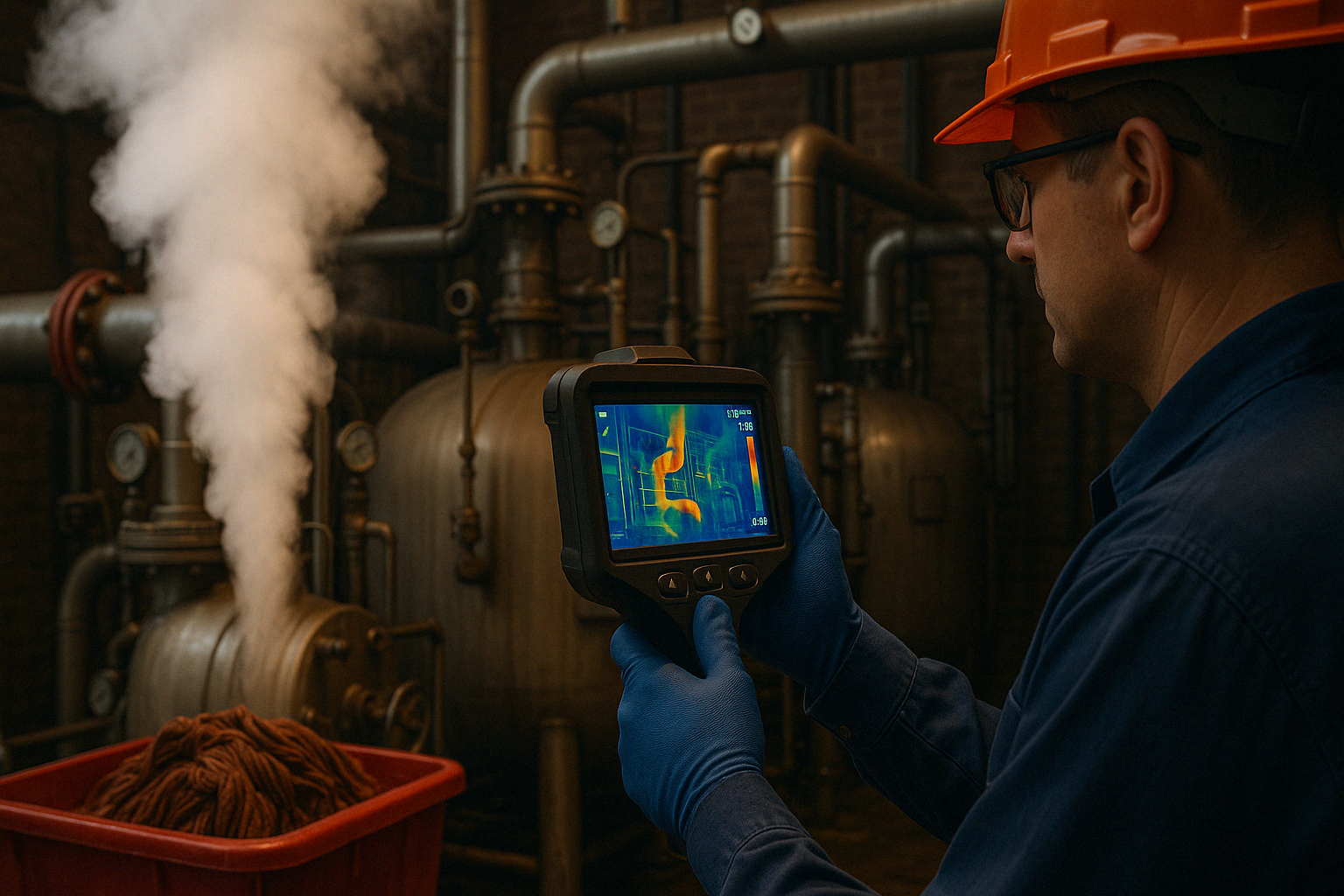Steam—The Hidden Cost Center
In the textile and apparel industry’s energy matrix, steam plays a vital but underappreciated role—especially in wet processing units where it powers dyeing machines, dryers, and finishing equipment. While electricity gets most of the attention in energy efficiency initiatives, thermal energy (primarily steam) often accounts for a larger share of both energy use and emissions, particularly in developing markets like Bangladesh, India, and Pakistan.
How Steam Systems Drain Profits Silently
The Dominance of Thermal Load
Energy audits across South Asia’s textile factories consistently show that steam accounts for 30–40% of total energy use, surpassing electricity in cost intensity in many facilities. Generated by boilers—mostly running on diesel, coal, or furnace oil—steam is distributed across a labyrinth of pipelines to various wet processing points.
Distribution Losses and Maintenance Gaps
Most factories suffer from outdated infrastructure:
- Uninsulated or degraded steam lines
- Faulty or absent condensate recovery systems
- Over-designed boilers running below capacity
- Manual blowdown procedures causing excessive purge losses
Such issues result in distribution losses of 12–20% and boiler efficiencies falling below 70%, far from the 85%+ levels cited in equipment brochures.
What the Data Tells Us
A 2024 multi-country audit (conducted by sustainability programs like IFC PaCT, GIZ FABRIC, and independent energy firms) found the following average metrics in wet processing factories:
| Indicator | Observed Range | Industry Best Practice |
|---|---|---|
| Boiler efficiency | 63–72% | 85% |
| Condensate recovery | <45% | >80% |
| Flue gas temperature | >200°C | <150°C with economizers |
| Steam loss in pipelines | 12–20% | <5% |
| Fuel overconsumption | 15–30% | 0–5% |
These inefficiencies translate into $10,000–$25,000/month in excess energy spending for mid-size units (25–40 tons/day), and hundreds of tons of avoidable CO₂ emissions.
Financial Anatomy of Steam
Let’s take a factory processing 30 tons of fabric/day using a 2-ton/hr diesel-fired boiler.
Monthly Cost Breakdown:
- Diesel Consumption: ~1,100 liters/day
- Fuel Cost: ~$36,000/month
- Boiler Maintenance & Downtime: ~$2,000
- Water Treatment & Chemicals: ~$1,500
🔎 Effective cost per ton of processed fabric from steam input alone: ~$44–$48/ton
In many cases, factories spend 10–15% more than necessary due to inefficiencies—without realizing it.
Recovery Levers and Payback Models
Factories often overlook cost-effective interventions. Based on empirical data from implemented projects:
High ROI Interventions
| Solution | Savings | Payback |
|---|---|---|
| Condensate recovery system | 15–25% fuel saved | <12 months |
| Flash steam recovery unit | 8–10% latent energy captured | 6–10 months |
| Boiler sequencing & automation | 5–8% fuel reduction | <1 year |
| Economizer on flue gas line | 6–10% improvement | ~18 months |
Despite the savings potential, adoption remains low due to lack of awareness and fragmented ownership structures in many factories.
Electric Boilers—A Paradigm Shift or Niche Fix?
Electric steam generators (resistance or electrode types) are gaining traction—especially in facilities with solar power or stable grid access.
Benefits:
- 95–99% thermal efficiency
- No flue gas = zero local air emissions
- Easier automation and digital control
- Compact footprint
ROI Case Study: Electrode Boiler Retrofit
- CapEx: $35,000
- Monthly fuel savings: ~$6,000
- CO₂ emissions cut: ~18 tons/month
- Payback: ~2.3 years (shorter with rooftop solar offsets)
Barriers:
- High upfront cost for small factories
- Electricity tariff volatility
- Grid reliability issues in certain zones
Still, in regions with rising fuel prices and falling solar costs, electric boilers are approaching economic parity.
Strategic Implications for the Textile Industry
Buyer & Brand Pressures
Global fashion brands are beginning to require Scope 1 emission disclosures, which include on-site fuel combustion—like steam generation. Factories unable to show carbon intensity reduction risk:
- Losing preferred supplier status
- Disqualification from “green” financing
- Reputational damage in ESG reporting
Compliance and Financing Opportunities
- Programs like Bangladesh’s BIIDF, India’s UDYOG RATH, and Pakistan’s NEECA are offering subsidies, matching grants, or low-interest loans.
- IFC’s Sustainable Energy Finance (SEF) toolkit also supports energy-efficient steam systems.
Steam Optimization Is No Longer Optional
Steam represents one of the most under-audited and under-optimized cost centers in textile manufacturing. The combination of:
- Rising fuel prices
- Emission compliance pressure
- Energy inefficiency
- Available technologies
…makes this the right time to rethink steam.
Factories that embrace energy audits, invest in recovery, and pilot electrification will not only reduce costs, but also future-proof themselves in an increasingly sustainability-driven supply chain.
